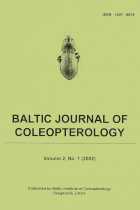THE CARABID FAUNA (COLEOPTERA: CARABIDAE) OF FOREST STANDS ON COLLIERY SPOIL HEAPS
Main Article Content
Keywords
:
Carabidae, urban environment, colliery spoil heap, recultivation, succession
Abstract
The carabid beetle communities of two different forest stands growing on colliery spoil heaps were analyzed over a period of several years. The data collected were compared with data from ten forest stands not growing on colliery spoil as well as with data from four colliery spoil heap sites at an early stage of succession. The collection of the beetles was carried out using pitfall traps. Trapping times covered whole vegetation periods. Portions of typical forest carabids, and unwinged carabids as well as values of mean individual biomass (MIB) are low for forest stands on colliery spoil in comparison with forest stands not growing on colliery spoil, but increased in comparison with colliery spoil heap sites of early stage of succession. High species turnover values can be observed for the forest stands growing on colliery spoil. The most abundant species fluctuate to a high degree and show an erratic pattern.The results indicate that on forest stands on colliery spoil heaps a delayed succession takes place. One may assume that this is caused by a slow development of the soil. The possibility is discussed, if other methods of recultivation based on the method of natural succession will lead to better results. Furthermore, in the scope of recultivation of colliery spoil heaps aspects of nature conservation should be taken into account; e.g. colliery spoil heaps can serve as secondary habitats for endangered species.
Article Details
Statistics
Downloads
Download data is not yet available.
Recommend Articles
